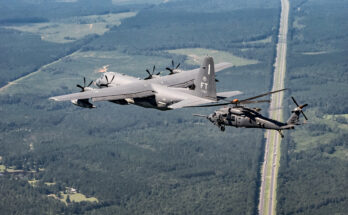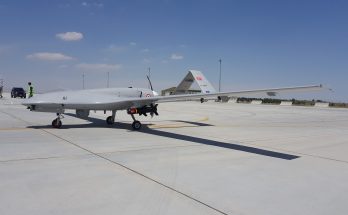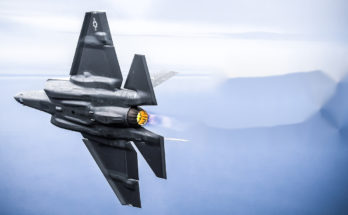The Air Force’s FY20 budget request totals $204.8 billion, reflecting a 5.4 percent increase over the $194.3 billion provided for the service in FY19. However, it is important to remember that the Air Force budget includes a large chunk of classified pass-through funding for other agencies. The portion of the budget actually controlled by the Air Force, also referred to as the Blue budget, is $165.6 billion in FY20. That figure is 6.3 higher than the previous year’s enacted level for Blue funding.
The service is seeking $50.1 billion for procurement programs, which is $801 million below the FY19 enacted level. As with the topline budget, however, the procurement account includes a large amount of non-Blue funding. In fact, less than half of the Air Force’s procurement account actually supports Air Force programs. The budget request includes $25.9 billion in Blue procurement dollars, down slightly from $26 billion enacted in FY19. Non-Blue procurement funding is contained in the Air Force’s Other Procurement account.

Source: U.S. Air Force FY20 budget briefing slides
The FY20 budget plan bolsters Air Force procurement spending in the outyears. Compared to previous spending plans, the service would receive an additional $13.6 billion between FY21 and FY23. However, 90 percent of that increase comes from the Other Procurement account, meaning the additional funding could represent non-Blue programs outside of the Air Force. The Air Force’s ammunition account is $1.1 billion higher than planned in FY20 as the service rebuilds stockpiles, and the budget increases ammunition funding by a further $1.1 billion between FY21 and FY23 compared to the previous year’s plan. The Air Force wants $17.1 billion for aircraft in FY20, which is $974 million below the FY19 enacted level and $1.7 billion less than originally planned. Compared to FY19 projections, the outyear spending plan for aircraft is bolstered by $845 million in FY21 and $451 million in FY22, but reduced by $827 million in FY23.
As with the other major services, the request includes a significant increase in funding for research, development, test and evaluation in FY20 and beyond. The RDT&E budget totals $46.1 billion in the FY20 request, which is $4.6 billion above FY19 enacted levels and $4.5 billion more than the Air Force originally planned for FY20. Blue RDT&E funding totals $35.4 billion in FY20, which is 15 percent more than enacted in FY19. RDT&E spending is increased by another $7.5 billion (Blue and non-Blue) between FY21 and FY23, falling short of Navy and Army increases of $11.8 billion and $9.2 billion, respectively, over the same period.
Aircraft
The Air Force is restarting procurement of the F-15 fighter to replace aging F-15C/D aircraft in the Air National Guard, requesting $1.1 billion for eight F-15EXs. The EX is an upgraded variant based on the two-seat F-15QA for Qatar. The service plans to buy 80 aircraft over the course of the Future Years Defense Program. The Air Guard operates five F-15 wings as homeland defense assets, and a sixth wing is used for training. The Air Force has fewer operational F-35s today than it originally planned, and views the F-15 as a cheaper and quicker option to recapitalize the Air Guard fleet. The move goes against previous Air Force claims that it would only buy fifth-generation aircraft like the F-35.
Officials have insisted that the F-15 buy will not impact F-35 procurement. The service is seeking 48 F-35As in FY20 as planned, but outyear procurement rates have been reduced from 54 aircraft per year to 48 aircraft per year. A number of lawmakers have questioned the F-15 purchase, and Congress may intervene during the FY20 budget markup process. The Air Force has said it wants to buy 72 fighter jets per year, so the 56 jets in the FY20 budget falls well short of that goal. Despite the reduction in outyear F‑35A procurement rates, the Air Force has bolstered funding for the F-35 Block 4 modernization program. The service requested $794.4 million for Block 4 in FY20 compared to $598.5 million as originally planned.
A number of aircraft programs experienced cuts in the FY20 budget. The Air Force requested funding for 12 KC-46A tankers, three fewer than planned, and removed another three aircraft from its FY22 and FY23 procurement plans. The budget includes eight MC-130Js, a reduction of five aircraft from the original Air Force plans. The service wanted to begin procuring eight helicopters per year in FY20 to replace its UH-1N fleet, but those aircraft did not materialize in the FY20 request. Rather, the FY20 request calls for $171 million in research and development funding, which includes the cost of two system demonstration test article aircraft. The Air Force plans to seek $195.4 million in procurement funding in FY21, with $1.2 billion allocated for procurement between FY21 and FY24. Boeing and Leonardo won the UH-1N replacement competition with the MH-139 helicopter.
The budget includes 12 Combat Rescue Helicopters as planned, and pays for one Compass Call conversion. The Air Force is re-hosting existing EC-130H Compass Call mission equipment on new EC-37B aircraft, which use the Gulfstream G550 Conformal Airborne Early Warning Aircraft airframe. The Compass Call conversion effort continues at a rate of one aircraft per year, despite concerns from Congress about the slow pace of the transition. Lawmakers may increase funding to accelerate the program. The request includes two C-37B executive transports (based on the G550) to replace C-20B (Gulfstream III) aircraft that were retired in 2017. The Air Force also wants 12 MQ-9 Reapers, eight more than planned, as well as 18 RQ-20B Puma unmanned aerial vehicles. The FY19 request did not show any RQ-20B funding beyond an FY19 order funded through the Overseas Contingency Operations account. The new spending plan seeks a total of 91 RQ-20Bs between FY20 and FY24.

A pair of HH-60W Combat Rescue Helicopters are prepared for flight tests. Source: Sikorsky
Weapons
A number of weapons programs received more funding than projected under the FY19 budget, continuing a regular trend whereby the Air Force replenishes expended munitions. The FY20 request includes the following weapons:
430 Joint Air-Surface Standoff Missiles (JASSMs) – 70 more than planned
355 AIM-9X Sidewinders – in line with projections
220 AMRAAMs – 55 fewer than planned
3,859 HELLFIREs – 2,461 more than planned
7,078 Small Diameter Bomb I munitions – 3,255 more than planned
1,175 Small Diameter Bomb IIs – in line with projections
37,000 Joint Direct Attack Munitions – 26,200 more than planned
533 B61 life extension kits – in line with projections
Space
The Air Force is requesting $414.6 million for the first GPS III Follow-On satellite. The service previously anticipated buying two satellites in FY20. The program has also been moved to a new line item in the FY20 budget. The program was previously funded in the GPS III Space Segment line item, but now falls under the GPS III Follow-On line. Budget documents show two satellites being procured in FY21, followed by three per year between FY22 and FY24. The Air Force also wants $1.2 billion for four launch vehicles, one more than planned.

GPS IIIF rendering. Source: Lockheed Martin
The budget includes a plan to initiate the creation of a new Space Force within the Air Force. Ultimately, the administration wants to create a new military department for space, meaning the organization would stand alone on equal footing with the other major services. The Air Force proposes first creating a new service within the Department of the Air Force, and allowing the Space Force to mature before establishing a completely separate Department of the Space Force. The FY20 request includes $72.4 million for the initial stand-up of a new Space Force headquarters. The Air Force has been hesitant to support the creation of a completely separate military branch, which would result in the Air Force losing control of space assets and the budgetary power behind them.
Research & Development
On the research and development front, the Air Force wants $3 billion in FY20 for the B-21 bomber. The service has allocated a massive $13.9 billion for the program through FY24. The Next Generation Air Dominance program receives $1 billion in the request, which is $356.5 million less than planned. The NGAD program represents the future of the Air Force’s air superiority fleet. A total of $6.6 billion is set aside for NGAD development between FY20 and FY24. The Air Force includes $35 million in the request for continued O/A-X Light Attack experimentation, with another $35 million allocated in each of FY21 and FY22. Budget documents tentatively show an initial allotment of $160 million for O/A-X procurement in FY22, followed by $400 million in each of FY23 and FY24. However, the Air Force’s commitment to the program is suspect, and it remains to be seen if the experimentation will lead to a full-on procurement effort.

Planned B-21 bomber development funding
The budget includes $1.4 billion in development funding for the Next Generation Overhead Persistent Infrared program, a follow-on to the Space-Based Infrared System (SBIRS) missile warning satellites. A total of $11.4 billion is programmed for Next-Gen OPIR development over the FYDP. FY20 budget documents also outline two new projects within the program. One is the Block 0 Polar project, which receives $107.4 million in FY20. The other is the Block 1 project, under which the Air Force plans to acquire subsequent satellite blocks through a competitive process. Initial funding for Block I isn’t planned until FY24, when the Air Force anticipates needing $506.4 million. Block I satellite deliveries are not expected to begin until FY30.
The Air Force requests $712.5 million for continued development of the Long-Range Standoff Weapon, with $2.4 billion set aside over the next five years. Another $576 million is included in the budget for hypersonic prototyping, which funds work on the Air-Launched Rapid Response Weapon (ARRW) and the Hypersonic Conventional Strike Weapon (HCSW). ARRW, pronounced “Arrow,” is leveraging work from the Defense Advanced Research Projects Agency’s Tactical Boost Glide program.
As editor of International Military Markets, North America, Shaun has cultivated a deep understanding of the vast defense markets in the United States and Canada. Shaun's perspective on defense procurement and budget issues has been cited in a variety of defense periodicals, including Defense News and National Defense Magazine. Further, Shaun played an integral role in the development of Forecast International's U.S. Defense Budget Forecast product, which offers an unprecedented level of insight into the Pentagon's acquisition budget. In addition to providing original analytical content for the U.S. Defense Budget Forecast, Shaun oversees an internal defense budget forecasting process involving Forecast International's team of skilled systems analysts following release of the DoD's annual budget request. Shaun is also in charge of managing Forecast International's Weapons Inventory database.




